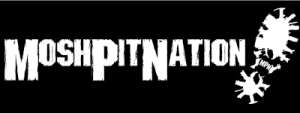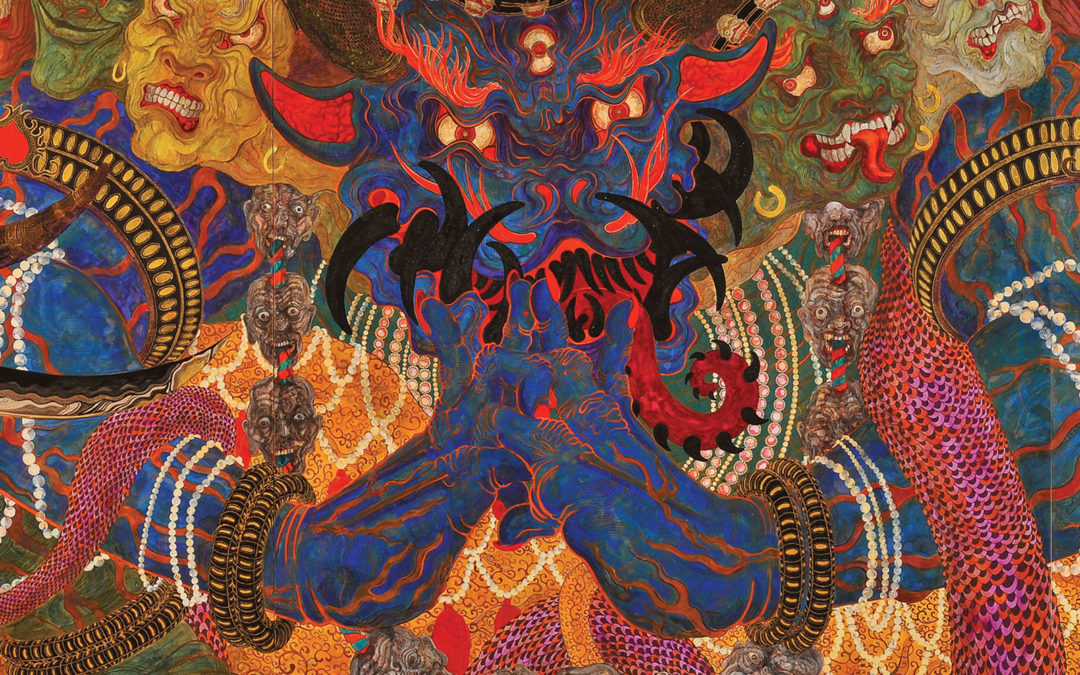Band – Neptunian Maximalism
Album – Éons
Country of Origin – Belgium
Genre – Drone/Free Jazz/Psychedelia
Release Date – June 26, 2020
Label – I, Voidhanger Records
Author – Hayduke X
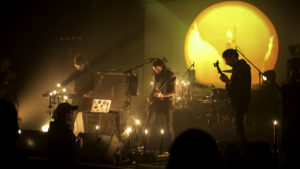
Sometimes music defies description. Allow me to present exhibit A, Éons by Neptunian Maximalism. This three-albums-in-one release is both dense and immense, not metal, but certainly metal-adjacent, and utterly, mind-blowingly impossible to describe, though I will attempt to do just that in this feature article. Before I begin however, let me draw your attention to the various moving parts of this article, as I wouldn’t want you to miss anything. This feature will include the following:
- Three different brief reviews, one for each of the three CDs included in the release, as each has its own character
- An exclusive stream of three conjoined tracks from the middle of the three releases
- An interview with Czlt, one of the initiators of this project and key creative forces behind it
- Pre-Order the 3-Disc set here.
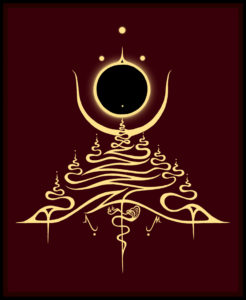
Track Stream
Before we get into the reviews and the interview, let’s just jump right into the music. It is with great pleasure that we present to you the three parts of Vajrabhairava, the second, third, and fourth tracks of Disc 2. They are respectively Vajrabhairava: The Summoning (Nasatanada Zazas!), Vajrabhairava: The Rising, and Vajrabhairava: The Great Wars of Quaternary Era Against Ego. As a whole, these three tracks form my personal favorite section of the entire nearly two and a quarter hours, but in all honestly, there is no part of the triple album that isn’t incredibly engaging. Give this section a listen, then read on.
Review
Disc 1 – To The Earth (Aker Hu Benben)
Massive blasts of rich, brassy horn start off an off kilter rhythms, like an of elephant herd on the move. Intricate percussion jabs in and out of the blasts, all over a droning mass of sound. To The Earth is psychedelic and strange, to be sure, but it is also very rooted. Tribal sounding rhythms underpin tightly controlled free jazz (sounds oxymoronic, I know, but there it is) to create a rich tapestry of sound, which drags you in, and then weaves its tendrils all around you. Though only loosely connected to metal – I would argue that drone is at least metal adjacent and the rhythms here are very solid and strong – this whole album will have your head nodding like you’re at a Dio concert. At moments, the tracks devolve almost completely into scattered fragments of disparate parts, but then they are picked back up, rearranged, and ready to have your head nodding again before you know it.
Of the three discs, this one has the most accessible sound to me. There is obvious improvisation at work, and certain parts are ominous, even approaching disturbing, but as a whole, it is the warmest of the three discs. By way of attempting to put into words what I’m getting at, consider the following allegory. Imagine the early part of a horror movie, where nothing really terrible has happened yet. The characters involved are maybe sunbathing, unaware of the dark possibilities ahead. Yet, the audience knows something is up, if for no other reason than it being a horror movie. That is somewhat the feel of this album.
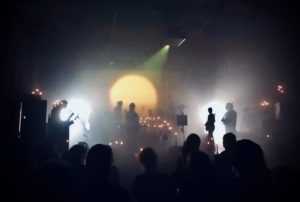
Disc 2 – To The Moon (Heka Khaibit Sekhem)
Disc 2 is the darkest of the three, fitting given the title. Consider this NNMM in moon phase, changeable, though still rhythmic. To The Moon begins in a more subdued manner, but quickly builds dramatic tension, most noticeably initially through compelling rhythmic work on the bass. The chaos, or lack thereof, ebbs and flows like the tide, though the tension just continues to ratchet up moment by moment. This initial track Zâr – Empowering The Phurba / Éon Phanérozoïque gets downright uncomfortable by he end, before transitioning into the darkness that is the Vajrabhairava trilogy. Go back up, click play, and allow yourself to spiral into that droning darkness for the next sixteen minutes.
Before moving on to disc 3, To The Moon gives two more statements for us to consider, for a total of another twenty minutes of so of runtime. They are akin to groping through a cave system in the dark. There is some natural structure there, but not a forced structure. This disc also features homo sapien proto-language, as researched by Cambridge scholar Pierre Lanchantin. Reach forward. Follow along. Let the sounds guide you into the other.
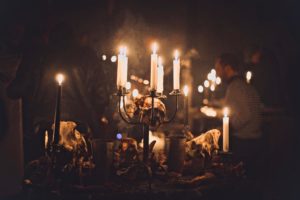
Disc 3 – To The Sun (Ânkh Maât Sia)
To The Sun is in some ways the most esoteric of the three. Think of it this way: To The Earth feels the most connected to life. To The Moon feels the most connected to death. To The Sun, then, feels like it’s above such petty concerns. Though only four tracks, this disc does feature the two lengthiest tracks on the entire release, taking it’s time to explore the farthest reaches of thought, the farthest reaches of the galaxy. Simultaneously the most mellow of the discs and the most disconcerting when taken as a whole, To The Sun is vast, and thus, hard to cope with emotionally.
Cycle after cycle of vibrations spiral out into the ether. Various instruments and voices intone within this crafted structure of reverberation. To The Sun is an exploratory vessel into the vast reaches of beyond. It will take you where it will. The purest journey will belong to those who can most fully let go. Ride the crest. Float into unbeing.
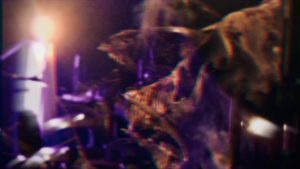
Interview
What follows is an extensive interview with Czlt. Answers are deep and meaningful.
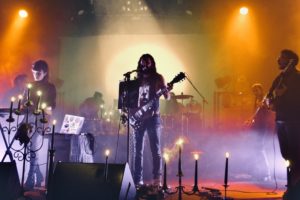
Hayduke X: Give me a brief rundown of when and how this project came together.
Czlt: With our saxophonist Jean Jacques Duerinckx, during the year 2017-2018, we practiced regularly in his improvised music laboratory (Lab’OMFI). After a convincing first duo performance (sax + drone guitar), I took the initiative to organize a residency at HS63 (Compilotheque) in March 2018, a self-managed place (legal squat) dedicated to the alternative scene. I wanted to invite a drummer, and the choice was for my cousin and music mate Pierre Arese (AKSU) and Sebastien Schmit (K-Branding), who had just told me that he was interested in playing with me. But there was confusion about their availability. In order not to disappoint anyone, I ended up offering them both to come.
This is how the adventure started: a baritone sax with octave down on amplifier, two drums and a baritone and bass guitar. We recorded our improvisations for two whole days and we gave a free improvisation concert on the third day:
Then I went home with these sound sockets and I mixed and arranged it for around three intensive months (sometimes five days without opening the door of my apartment … the sound engineers have some experience of “lockdown”) to give birth to the result which is the subject of our discussion.
HX: Wow! That’s really intense. What was your own musical background prior to launching NNMM?
Czlt: I had a lot of more or less formative experiences, but which answered my musical bulimia.
In Camargue, my native region (south of France), a land influenced by the flamenco culture, I started music theory and the trumpet at six years old at the music school, then the electric guitar six years later, as well as the bass and as a percussionist (congas) in an Afro-Cuban batucada, of which my cousin Pierre was a part (timbalero and snare).
Then I moved to Brussels. There, I joined the emerging group of grindcore VORAX VIROSUS, founded by my friend Gabriel Tapias (Ente, from Ecuador), as a bass player and singer. Then I was one of the initial members of the noise punk group SIAMESE QUEENS as a guitarist. In parallel I was doing solo breakcore (FXF KFB). I also started to make concert with Stephane Van Tricht (Excuses Excuses, Detrvire), thus forming our duo JENNY TORSE, always active in extreme black metal and chaotic and futuristic psychedelic. And at the same time, in 2012, to answer an exercise at my higher school of architecture, I invited my cousin to do an improvisation session in the school’s architecture museum, a building with the proportions of church. From there was born AKSU, grandfather of NNMM. Then I was part of the sludge doom psyche band BONEPIPE as a bass player and lead singer. I invested a lot as a composer and lyricist, as a graphic designer and artist, but our perspectives differed. I got fired from the group in 2017 after three years of work. It was very difficult to swallow and it cost me a few months without music.
And that’s when I met Jean Jacques and his Lab’OMFI. A few months later, a painful rupture made me give birth to a new compulsive secret “one man black metal” project. I vomited the equivalent of three albums in three months in early 2018, and today I have enough to get out of it at least five, including the first on Epictural Productions next month. In March 2018 it was NNMM’s turn. And finally, following a collaboration with contemporary artists Felix Luque and Iñigo Bilbao for their video “JUNKYARD” for which I played the soundtrack, I gave birth to CZLT. Then I fell in love with Indian music for good. I bought my first sitar last year and practiced thoroughly as an autodidact, thanks to the internet. This practice finally crystallized in CZLT, as well as on the track “HELIOZOAPOLIS” of NNMM.
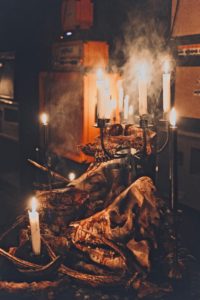
HX: What a wide variety of experiences. Can you clarify for me the name of the one-man black metal project? I’d like to check that out.
Czlt: ……..
HX: Thank you. In the project’s biography, NNMM is described as “cultural engineers”. What do you mean by this phrase?
Czlt: For my master’s thesis in architecture, “Goodbye Black Box, “A review of the architectural model dedicated to the representation of amplified music “, I was interested in the definition given by Genesis P-Orridge of his practice:
“In fact, I always feel extremely offended when I see, on an article or in a book, someone referring to me as a musician. I see myself as a cultural engineer; this is a more appropriate term. There already is music, and people like it. They already listen to music. This is part of society’s cultural mash, same as television. My vision includes everything that people work with, everything that touches them or mold them. ” (Modulations, Allia edition, 2010).

HX: That’s a really interesting connection. I’d like to spend some time talking about how the music is composed. How much is composed in advance? How much is improvised?
Czlt: As I said, first there was the residence at HS63 in total free improvisation. Then I reorganized the recordings into coherent songs, isolating the most interesting sessions. Then I started recording arrangements in my home studio myself: adding vocal parts, adding guitars and bass. Sebastien also came to record some backing vocals & gongs and Jean Jacques came to record the fabulous sopranino sax track in first strike for “The Conference Of The Stars”. I also decided to double parts in “octave down” (drums, vocals, etc.) to follow the logic of the baritone sax and the guitar which was already doubled originally in “octave down”, which contributes to give this particular sound.
On this basis we did a few other improvised concerts with a “Heavy Tribal” tendency, preceding a break which coincided with my departure for France for one year. When I returned, I wanted to revive the project. So I requisitioned the musicians who still wanted to participate in the adventure. My wish this time was to revive the “Drone” face of NNMM. So I trained new musicians to try to reinterpret the eponymous title of our first EP “The Conference Of The Stars”, as well as the song “ÉOS” on the album “To The Sun”, which will be released next month. The goal was to create a “Solar Drone Opera” with as many musicians as possible, playing on a unison principle by varying the timbres and decorative patterns. After three concerts in pure drone, Sebastien joined the drummer station, as we can see in the clip “ÉOS” (live @ HS63 2019) published today on the web. Then it was Stephane Fedele and Lukas Bouchenot who took the job. Since the project rocked a little more in a space rock / heavy psych.
In general, we therefore followed the diagram of these two pieces, to finally free themselves and reintegrate the improvised dimension, to free the musical game and that everyone can conquer their place and their musical individuality, rather than submitting to a 100% directive scheme. And we try to continue like this.
HX: According to the promotional material I received, Éons is an exploration of the transition from the anthropocene era into the probocene era. Do I have that correct?
Czlt: Yes that’s right. This traces the birth of the earth, the birth of life on earth made possible by the reign of primary mushrooms, the appearance of consciousness, until the end of homo-sapiens-sapiens which must imperatively transmute towards the “homo-sensibilis”, the man who knows he doesn’t know. It is not a “I think, therefore I am”, but rather a “I feel, therefore I am”.
It is only from there that we can considerably reevaluate our relationship with the living, especially with animals. In fact, if we come to consider animals as potential “human beings” in the making, then we will consider reducing our ecological pressure since they will be considered as our equals, even withdrawing from the scene of the living . It would perhaps be the only act truly worthy of making us “humans”.
At that time, it is possible that certain species are candidates for higher consciousness. They have all always been, but evolution is also a timely opportunity that must be seized when the favorable factors converge. We must therefore project ourselves onto temporalities which considerably exceed that of our existence, which is so slim in view of life on earth.
On the continent, elephants are considered by some scientists as those who could have been superiorly aware, if men had not exerted this ecological pressure, which is moreover not only characteristic of hominous humans (who descend from large primates).
In the summary “TO THE SUN”, I therefore created new concepts like that of the geological era “Evaísthitozoïque” “Flamboyant Probocene”, signifying an era of the sensitive, here at the stage where the conscious elephants (Proboscidea-sapiens ) changed their geological environment at the time when their civilization reached its peak. This climax takes place in “HELIOZOAPOLIS”, literally the solar city of animals, like a city erected not by hominin humans (us) but animal humans, including human elephants.
Be careful. That does not mean that they have a human morphology or appearance. They are what we are still incapable of conceiving, because “thinking” with a trunk gives rise to an intelligence just different from ours, no less. This is why the question arises: do animals think as we think they think? (Vinciane Despret). This non-anthropo-centered question opens up in the scientific and philosophical world a heavy debate on animal consciousness which I hope will tend to make homo-sapiens-sapiens take a real turn to “homo-sensibilis”.
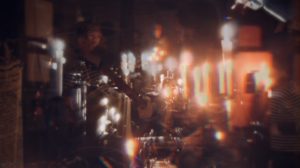
HX: Éons is divided into three separate but connected albums. Up first is “To The Earth (Aker Hu Benben)”. Tell me about this album. What do you hope listeners will experience as they explore “To The Earth”? What do you do musically on these tracks to reach those goals?
Czlt: I prefer to give the benefit of their own feelings. But I think of the raising of the tectonic plates, the stammering of primordial soup, the light breaking the black sky after the storm, war, dance, magic, the viscous glide towards sedentarization after the first tools to kill better, the agriculture and the breeding which made possible the teeming cacophony of the first cities.
But since it was improvised music originally, it was not a goal in itself. Music has become what it is, that’s all. This whole landscape was contained in us, and we simply gave birth to it, with all the violence of childbirth.
And as far as live performances are concerned, the musical color depends very much on the line-up, which has never been the same twice. Currently, we are nine musicians with very pronounced identities and various nationalities. It is the most ultimate formula we have experienced to date. Their role is essential in the direction the project is taking, but it cannot be explained. They speak for themselves, with their instruments. Freedom is the key to setting off on an adventure in new territories, so we cannot sum it up to a method, as the derogations from the rule are an integral part.
Then our musical interpretation will depend a lot on the architecture of the place, the connection and the dialogue that we intuitively maintain with it. Light also plays a fundamental role, especially since we played with the candle as well as below a large projected solar disk.
Which brings us to the question of magic, the one brought up by L. from “A Thousand Lost Civilization”. When he deploys his scenography and his incense, something unspeakable happens.
HX: Understandable. I would like to talk a little more specifically about “Vajrabhairava” since we will be streaming all three parts of it for this feature. I’ll just let you share what you’d like to say about what is my favorite part of this opus.
Czlt: Vajrabhairava is of pure anger and full power. It was the most powerful invocation in the realm of darkness that was heard. The voices of the first hominins worthy of articulated language took possession of me. And as 2001 A Space Odyssey portrays in its first chapter, the first crime of monkeys to literally crush the brains of men to come. The taste of genocide.
Opened by taking psychotropic drugs, the still pure consciousness gradually tainted.
This state of being will give, among other things, the appearance of the city, which in Act three takes on the appearance of a “souk”. This image crystallizes the treasures but also the plagues of humanity. The surreal quirk that radiates from something foreign.
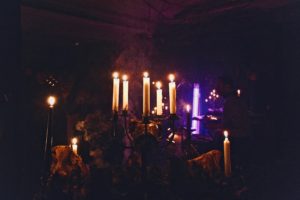
HX: Will you speak some more about magic?
Czlt: As for magic, it’s difficult to discuss it because I am too modest on my knowledge on this subject. All I can say is that I practice certain things, and more daily Jodorowsky’s Tarot de Marseille. But music is for me a magic practice. It is a purely apophantic and performative discourse, which is therefore neither “true” nor “false” and which takes effect in the real world when it is delivered. And in many cultures around the world, music is the most direct means of communicating with the gods or the other world. Whether by trance or by sacred music, each constituent element of which plays a precise symbolic role in the writing of speech. Unsurprisingly, this clearly resembles the practice of magic in terms of intention and achievement. I stay connected to all this vision there.
HX: This album is being released by I, Voidhanger Records. How did you end up signing with them?
Czlt: Just by sending a label summoning by email
HX: The label is primarily a metal label, though a very forward thinking one. Do you have concerns about reaching the correct audience?
Czlt: I don’t ask myself that question too much. But I think there are a lot of metalheads who are quite open-minded. I think the genre has evolved remarkably in recent years and a good label is a guarantee of confidence for us. I simply believe very strongly in this project and Lucianno believed in it. We have established a human and warm relationship. This is what matters to me. And the label, what can I say, WOW, I find albums that I love, crazy works of art .. that also counts, it’s an honor for me.
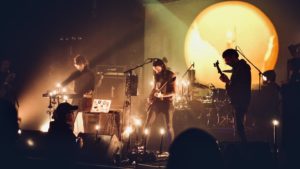
HX: What’s next for the collective, especially after life returns to some semblance of normalcy after the pandemic?
Czlt: For the future, we plan to record in the studio of the two drummers the sauce that we play live with our new complete line-up. Also a “dark session” for Black Mara, the release of our last live performance, and I hope for a vinyl edition accompanied by quality merch including amulets bearing the group’s image. Also to develop very strongly our scenography and artistic collaborations.
And I don’t know if I can talk about it, but I take the risk. A projected tour with with two fucking good bands (but it’s still a secret) for 2021 organized by A Thousand Lost Civilizations. It may be really huge .. And of course as many lives as possible, as soon as the concert halls and festivals reopen. We dream of playing “L’Homme Sauvage” in the Pyrenees, at the Desert Fest, at the Sonic Blast in Moledo, at the Brutal Assault, of course at the Roadburn or even at the incredible Duna Jam, to name a few ! I hope this dream will come true one day!

HX: And for the final official question, is there anything else you’d like to share with our readers?
Czlt: Thank you from the bottom of my heart to those who take the time to listen to us and to enter our universe. Thank you to the people who encourage us, by message or during the concerts. Thank you to our friends who are our family here in Brussels, they are an irreplaceable treasure.
And above all ,l I would like to say how proud I am of the musicians with whom I play in this project. They are also irreplaceable, and their personality is just fabulous. They have changed so much the vision that I projected at the beginning, and this for the better, beyond my expectations. It was the best group experience of my life (with more members than a duo). The atmosphere is just great and everyone seems to be in the right place. I love each of them, from past members to current members.
And thank my gods, and Satan for lighting up the darkness of this world with his light. All this is full and pure power, rather than will or necessity. As Giorgio Agamben puts it so well, “to want is to order yourself to obey”. So, instead of thinking “I want” or “I must”, think about power, possibilities, think “I can” (or “I can’t”, that’s ok). Whatever you can, you can.
![]()
Biography: Hayduke X has been writing for MoshPitNation since June of 2016. Beginning in 2018, he also began writing for VM Metal Underground. Prior to joining the MoshPitNation team, Hayduke published reviews on his own blog Rage and Frustration. In addition, he has DJ’ed an online metal radio show of the same name as his blog, written for TOmetal.com, done interviews for Metal Rules, and collaborated with The Art of B Productions to create video interviews with a wide variety of bands.
